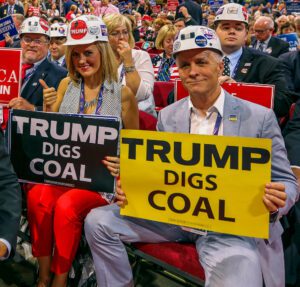In a move that has sent ripples across the political landscape, Senator Joe Manchin of West Virginia announced his retirement from the United States Senate. This decision marks a significant moment in American politics, particularly for the state of West Virginia, a region that has undergone a dramatic political transformation in recent years.
Once a bastion of Democratic strength, West Virginia has rapidly transitioned to a deep red-leaning state, a shift that has profound implications for both state and national politics. This change is not just a reflection of shifting party loyalties but also indicative of deeper socio-economic and cultural realignments within the state. Senator Manchin’s retirement signifies more than just the conclusion of an era for West Virginia in the Senate; it represents a pivotal shift in the political landscape of a state that, while not large in electoral power, has mirrored and influenced broader national trends. As a moderate Democrat from a predominantly red state, Manchin wielded considerable influence in shaping legislative outcomes during both the Trump and Biden administrations, often serving as a critical and decisive voice in a deeply polarized political environment.
As we delve into the intricacies of this political evolution, it’s crucial to understand the factors that have propelled West Virginia from its blue roots to its current red hue. This shift raises important questions about the state’s future political trajectory and its impact on the broader American political landscape, especially as we approach the 2024 elections.
West Virginia’s political landscape, known for its recent shift towards the Republican Party, has a history marked by significant changes in political allegiances and economic realities. This evolution reflects broader trends in American politics, especially in rural and working-class communities.
The rise of the coal industry was instrumental in shaping West Virginia’s political identity. It influenced not only the state’s economy but also its social fabric. Labor unions, notably the United Mine Workers of America, became significant political entities, advocating for workers’ rights and aligning with the Democratic Party’s platform. Their influence was crucial in securing the working-class vote for the Democrats.

However, the turn of the millennium marked a gradual erosion of this Democratic base. Economic challenges, cultural shifts, and changing national political tides began to sway West Virginia’s allegiance toward the Republican Party. This transition was a steady realignment, reflecting its people’s evolving priorities and values.
The initial signs of West Virginia’s political realignment emerged in the 2000 presidential election. The state, which had historically supported Democrat Bill Clinton in 1992 and 1996, pivoted to Republican George W. Bush in 2000. Bush’s victory with 51.9% of the vote, overtaking Al Gore’s 45.6%, marked a notable departure from West Virginia’s traditional voting patterns and signaled the beginning of a significant political reorientation. This shift was partly influenced by Bush’s policies that resonated with the state’s economic interests, particularly in the coal industry.
This trend not only continued but gained momentum in subsequent elections. In 2004, George W. Bush expanded his margin, capturing 56.1% of the vote against John Kerry’s 43.2%. The growing Republican preference in West Virginia was a clear indication of the state’s alignment with the GOP’s economic and social policies, which were increasingly seen as more favorable to the state’s interests.
The preference for Republican candidates was even more pronounced during Barack Obama’s presidential campaigns. In 2008, John McCain won 55.6% of the vote to Obama’s 42.5%. The divide widened in 2012, with Mitt Romney securing 62.3% of the vote compared to Obama’s 35.5%. These election results not only highlighted a deepening political and cultural divide between West Virginia and the national Democratic Party but also reflected the state’s growing disconnection with the Democratic Party’s evolving stance on environmental and social issues.
 Donald Trump’s election further solidified West Virginia’s status as a Republican stronghold. In 2016, Trump won an overwhelming 68.5% of the vote, while Hillary Clinton received 26.4%. This trend continued in 2020, with Trump capturing approximately 68.6% of the vote to Joe Biden’s 29.7%. Trump’s populist rhetoric, particularly his emphasis on revitalizing the coal industry and his alignment with conservative social values, found a strong resonance with West Virginian voters.
Donald Trump’s election further solidified West Virginia’s status as a Republican stronghold. In 2016, Trump won an overwhelming 68.5% of the vote, while Hillary Clinton received 26.4%. This trend continued in 2020, with Trump capturing approximately 68.6% of the vote to Joe Biden’s 29.7%. Trump’s populist rhetoric, particularly his emphasis on revitalizing the coal industry and his alignment with conservative social values, found a strong resonance with West Virginian voters.
Central to this shift is the coal industry’s decline, which has profoundly impacted West Virginia’s economy and identity. The coal industry’s downturn left many residents feeling abandoned by the Democratic Party, traditionally seen as supporting coal and labor. This perceived departure, particularly amidst growing environmental concerns and the push towards renewable energy, created a political vacuum. The Republican Party capitalized on this by advocating for the revitalization of the coal industry and opposing stringent environmental regulations, resonating with the state’s immediate economic concerns.
Additionally, cultural shifts at the national level, particularly on social issues like gun rights and abortion, contributed to this realignment. The Democratic Party’s move towards advocating stricter gun control measures and its strong support for abortion rights increasingly diverged from West Virginia’s traditionally conservative stance on these issues. In contrast, the Republican Party’s unwavering support for gun rights and opposition to abortion resonated more with the state’s conservative values, further driving West Virginia’s political shift towards the GOP.
The national political climate, particularly during the Obama administration, also played a significant role. Policies and rhetoric celebrated in other parts of the country often seemed out of step with West Virginia’s needs and values. For example, healthcare reform and environmental policies were viewed as contrary to the state’s interests, exacerbating the political shift. Its progressive stance on social issues contrasted with the state’s more conservative values.
This realignment, however, does not signify a complete congruence with Republican policies. Certain Republican stances, such as those on healthcare reform and environmental deregulation, may not fully align with the interests of many West Virginians. For instance, the state’s high rate of Medicaid enrollment and healthcare needs could clash with some Republican healthcare policies.
This divergence led to a gradual but significant realignment in West Virginia towards the Republican Party, seen as more reflective of the state’s economic interests and social values. This shift was not about abandoning core values but seeking a political representation aligned more closely with those values.
The transformation of West Virginia’s political landscape is not just a story of shifting voter allegiances; it’s also a narrative shaped by the strategic maneuvers of key political figures. The recent retirement of Senator Joe Manchin, a moderate Democrat, underscores this shift, highlighting the influential roles of Senate Minority Leader Mitch McConnell and Governor Jim Justice in steering the state’s political direction.
This shift in West Virginia is part of a larger Republican strategy aimed at regaining control of the Senate. Recruiting strong, influential candidates like Justice and securing high-profile endorsements are key components of this strategy. These efforts are not just about winning individual races; they’re about reshaping the political narrative to favor the Republican Party, a tactic that has proven effective in West Virginia.
With the strengthening of Republican dominance anticipated following Manchin’s departure, West Virginia’s political landscape is expected to align more closely with conservative policies. This shift, evident in areas such as energy, social issues, and economic development, is a natural progression of the state’s recent voting patterns favoring the GOP. Meanwhile, the Democratic Party faces a strategic challenge in the wake of losing a key figure like Manchin, necessitating a reevaluation of their approach to regain relevance in the state.
The political shift in West Virginia is not confined to federal elections but is also evident in state and local races. Over recent years, there has been a noticeable trend of Republican victories in these elections, indicating a deep-rooted change in the state’s political identity. This trend is reflective of a broader realignment within the state, where Republican candidates are increasingly resonating with voters on local issues, further solidifying the GOP’s hold on West Virginia’s political landscape.
The upcoming 2024 Senate race in West Virginia is set to be a key battleground, with the potential to significantly influence the balance of power in the U.S. Senate. The Republicans, leveraging the state’s political realignment, have a substantial opportunity to strengthen their Senate majority. For the Democrats, this race will be a test of their ability to adapt and present a candidate who can connect with West Virginia’s shifting electorate.
In the presidential race, Donald Trump’s anticipated candidacy is expected to perform exceptionally well in West Virginia, potentially surpassing his 2020 performance. Recent polling data indicates Trump’s increasing popularity among Republicans in states with similar economic and cultural landscapes to West Virginia, suggesting a broader national trend. This growing support for Trump in states like West Virginia could be a bellwether for his performance in the upcoming presidential election, reflecting the national electoral dynamics in regions impacted by similar economic and social factors.
As West Virginia continues its political journey toward Republican dominance, the implications of this shift extend beyond the state’s borders. The evolving political landscape in West Virginia, marked by significant federal and local changes, offers a microcosm of the shifting political tides in the United States. The state’s trajectory towards the GOP, influenced by economic, cultural, and national political factors, provides valuable insights into the challenges and dynamics of American politics as the nation approaches the 2024 elections.